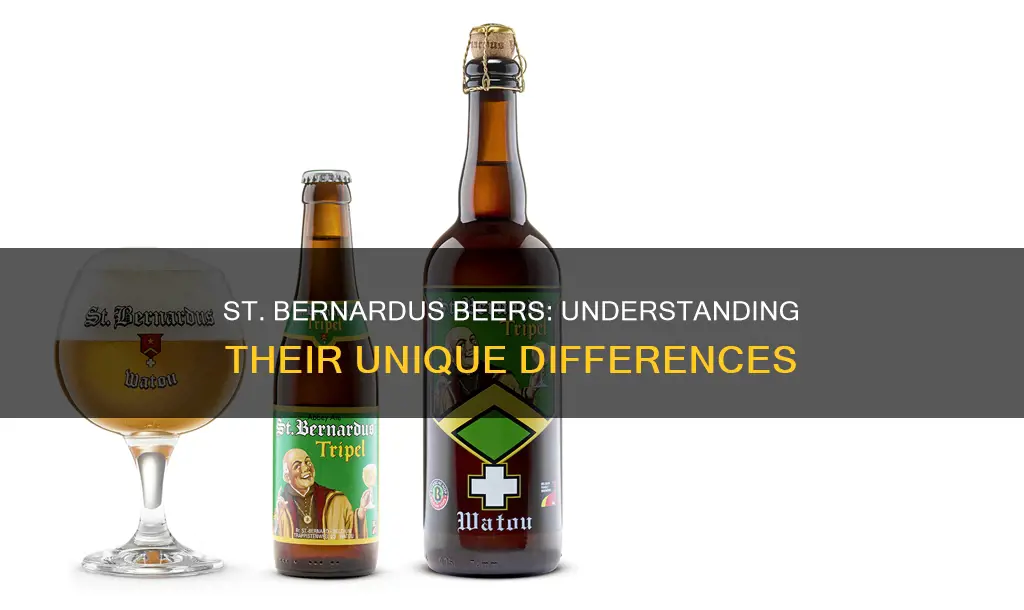
St. Bernardus is a Belgian brewery that has been producing traditional beers for over 70 years. They have a global reputation and are sold in over 30 countries. They produce a range of beers, including the well-known Abt 12, a complex, award-winning quadrupel with notes of dark fruit, caramel, and chocolate. Other beers in their range include the Extra 4, Pater 6, Prior 8, Tripel, Witbier, Tokyo, and Christmas Ale. The St. Bernardus beers are considered a close match in recipe and style to the St. Sixtus beers, which can be hard to obtain outside of Belgium.
What You'll Learn

St. Bernardus Brewery history
St. Bernardus Brewery is located in Watou, Belgium. The history of the brewery dates back to the late 19th century when anti-clericalism in France forced the Catsberg Abbey Community to relocate to Watou, in West Flanders, Belgium. The Refuge Notre Dame de St. Bernard was established, and the monks initially produced cheese to finance their activities. In 1934, the Belgian annex was closed, and all monastic activities returned to France, with Evarist Deconinck taking over the cheese factory.
In 1945, the story of St. Bernardus Brewery took a new turn. The Trappist monastery, St. Sixtus, stopped selling its beer commercially and agreed that their beer would only be available at the monastery and associated taverns. They granted a license to the cheese factory, and together, they founded Brewery St. Bernard. The partnership brought the expertise of Mathieu Szafranski, the brewmaster from Westvleteren, who contributed the recipes, yeast strain, and brewing knowledge. This marked the beginning of brewing activities at the site.
For almost two decades, Deconinck brewed and sold Trappist beers under license. In 1962, a new contract was signed, continuing the collaboration. However, in 1992, the agreement between the monastery and the brewery came to an end as the Trappist breweries decided that the "Authentic Trappist Beer" label would only be given to beers brewed within an abbey. As a result, the brewery had to rebrand, and the beers brewed in Watou were subsequently sold under the brand name St. Bernardus.
The change in branding also led to a shift in positioning. The brewery faced a period of uncertainty and worked hard to revive its fortunes. In 1998, Hans Depypere took over the brewery, initiating a process of revitalization and innovation. Under his leadership, sales witnessed significant growth, and new facilities were added to meet the increasing demand. The brewery also expanded its offerings, including guided tours and accommodation for guests.
Over the years, St. Bernardus Brewery has continued to invest in infrastructure, quality, sustainability, and enhancing the visitor experience. As of 2023, their annual sales have reached 50,000 hectolitres, with a presence in more than 80 countries. The United States is their largest foreign market, followed by the Netherlands and France.
Wheat Beer vs Lager: What's the Difference?
You may want to see also

Trappist monks' involvement
The involvement of Trappist monks in the St. Bernardus Brewery began in the 19th century when the Catsberg Abbey Community was forced to move from France to the village of Watou in West Flanders, Belgium, due to anti-clericalism. The Refuge Notre Dame de St. Bernard was established, and the monks initially produced cheese to finance their activities. In 1934, the Belgian annex was closed, and the monks returned to France, selling the cheese factory to Evarist Deconinck.
In 1945, the Trappist monastery St. Sixtus stopped selling its beer and reached an agreement with Deconinck. According to the agreement, the monks would brew beer for themselves, and the beer could only be purchased at the monastery and its associated taverns. Deconinck was granted a license, and the St. Bernard Brewery was founded. Mathieu Szafranski, the brewmaster from Westvleteren, became a partner in the brewery, bringing the recipes, expertise, and the St. Sixtus yeast strain.
Under this arrangement, Deconinck brewed and sold Trappist beers under license until a new contract was agreed upon in 1962. However, in 1992, the Trappist monasteries decided that Trappist beer could only be brewed within a monastery, bringing an end to the agreement with Deconinck. Since then, the beers brewed in Watou have been sold under the brand name St. Bernardus, retaining the recipes and yeast strain from their previous partnership with the Trappist monks.
The St. Bernardus Brewery has a strong connection with Trappist monasteries. The name "St. Bernardus" was derived from the nearby Mont des Cats Abbey in France, and the original recipes for their beers were obtained from the Trappist monks of Sint Sixtus Abbey. Although the license agreement ended in 1992, the current owners of St. Bernardus maintain a respectful relationship with the monks, abiding by the agreed-upon terms of use, including refraining from using Trappist terminology and imagery on their products.
Beer vs Shandy: Understanding the Core Differences
You may want to see also

St. Bernardus Abt 12
The St. Bernardus Brewery, located in Watou, Belgium, has a fascinating history. It was originally a cheese factory established by the Catsberg Abbey Community, who moved to the village of Watou from France due to anti-clericalism in the late 19th century. In 1945, the nearby Trappist monastery, St. Sixtus, stopped selling its beer to the public, and an agreement was made for the monks to brew only for themselves. St. Sixtus granted the cheese factory a license to brew and distribute Trappistine beers based on their recipe. This arrangement continued until the early 1990s when it was decided that only beers brewed within a monastery under the direct control of monks could be called Trappist beers. As a result, the St. Bernardus Brewery launched its own brand of abbey beers, including the now-famous St. Bernardus Abt 12.
Wine vs Beer: Art of Fermentation Explored
You may want to see also

Other St. Bernardus beers
St. Bernardus Brewery, located in Watou, Belgium, has been producing traditional beers for over 70 years. The brewery was founded in 1946 by Evarist Deconinck, who was granted a license by the Trappist monks of the St. Sixtus Monastery in Westvleteren, Belgium, to brew and distribute Trappist beers based on the monastery's recipe. Today, the brewery offers a range of beers, including award-winning brews like the Abt 12 and Prior 8.
St. Bernardus Tripel (8% ABV): A Belgian-style tripel brewed using traditional methods like open fermentation and bottle conditioning. It has an ABV of 8% and is available in 330ml and 750ml bottles.
St. Bernardus Extra 4 (4.8% ABV): A lighter and more refreshing option from St. Bernardus, with an ABV of 4.8%. It is available in a 330ml bottle.
St. Bernardus Pater 6 (6.7% ABV): This abbey ale is another offering from St. Bernardus, with an ABV of 6.7%. It is available in an 11.2 oz bottle.
St. Bernardus Prior 8 (8% ABV): An award-winning abbey ale with an ABV of 8%. It is available in 11.2 oz and 750ml bottles.
St. Bernardus Wit (5.5% ABV): A lighter option from St. Bernardus, with an ABV of 5.5%. It is available in 11.2 oz cans and 330ml and 750ml bottles.
St. Bernardus Tokyo (6% ABV): A unique offering from St. Bernardus, with an ABV of 6%. It is available in 330ml cans.
St. Bernardus Christmas Ale (10% ABV): A festive offering from St. Bernardus, available only during the winter season. It has an ABV of 10% and is available in a 750ml bottle.
Explore the World of Beer: Case Options and More!
You may want to see also

Beer pairings
St. Bernardus is a Belgian brewery that has been producing traditional beers for over 70 years. They have gained a global reputation and are sold in over 30 countries. The St. Bernardus range is considered a close match in recipe and style to the St. Sixtus beers, which can be hard to obtain outside Belgium.
St. Bernardus Abt 12
St. Bernardus Abt 12 is a dark beer with a fruity aroma, complex tastes, and a bittersweet finish. It is widely regarded as one of the best beers in the world. This beer pairs well with rich beef dishes, game, and the famous stoverij beef stew or rabbit. For cheese lovers, a blue cheese like Roquefort is an excellent match. Abt 12 also pairs surprisingly well with chocolate.
St. Bernardus Tripel
A golden, strong ale with a fruity aroma and a subtle bitterness. It pairs well with spicy dishes, strong cheeses, and desserts.
St. Bernardus Extra 4
A refreshing, easy-drinking blonde ale with a subtle bitterness and a fruity aroma. It pairs well with light dishes such as salads, seafood, and chicken.
St. Bernardus Pater 6
A dark amber ale with a malty aroma and a hint of caramel. It pairs well with grilled meats, barbecue, and mature cheeses.
St. Bernardus Prior 8
A strong, dark amber ale with a fruity aroma and a hint of spice. It pairs well with grilled meats, stews, and mature cheeses.
St. Bernardus Christmas Ale
A strong, dark ale with a fruity aroma and a hint of spice. It pairs well with roasted meats, rich stews, and Christmas pudding.
St. Bernardus Witbier
A refreshing wheat beer with a citrus aroma and a hint of spice. It pairs well with light dishes such as salads, seafood, and chicken. It also goes well with spicy foods.
Explore Lager and Helles Beer: Styles, Taste, and Origins
You may want to see also
Frequently asked questions
St. Bernardus Abt 12 is widely considered one of the best beers in the world. It is a dark beer with a fruity aroma, a complex taste, and a bittersweet finish. While it is similar to Westvleteren 12 in terms of recipe and style, there are minor differences in the final product due to different production methods and locations.
Beers that are often compared to St. Bernardus Abt 12 include Rochefort 10, Pannepot, Chimay Blue, and La Trappe Quadrupel. These beers fall into the quadrupel style and are known for their complex flavours and high alcohol content.
St. Bernardus offers a range of beers, including:
- Tripel (8% ABV)
- Extra 4 (4.8% ABV)
- Pater 6 (6.7% ABV)
- Prior 8 (8% ABV)
- Abt 12 (10.0% ABV)
- Witbier (5.5% ABV)
- Watou Tripel (7.5% ABV)
- Tokyo (6% ABV)
- Christmas Ale (10% ABV)
The St. Bernardus Brewery was founded in 1946 by Evarist Deconinck in Watou, Belgium. It was originally established to brew and distribute Trappist beers for the St. Sixtus Monastery, as the monks wanted to focus on their religious activities. However, in 1992, the arrangement ended, and St. Bernardus launched its own brand of abbey beers, which have since become award-winning and globally recognised.
St. Bernardus beers are distributed in over two dozen countries, including the United States, Canada, Brazil, Australia, and Japan. You can find their beers in specialty beer stores or order them online from authorised retailers.







